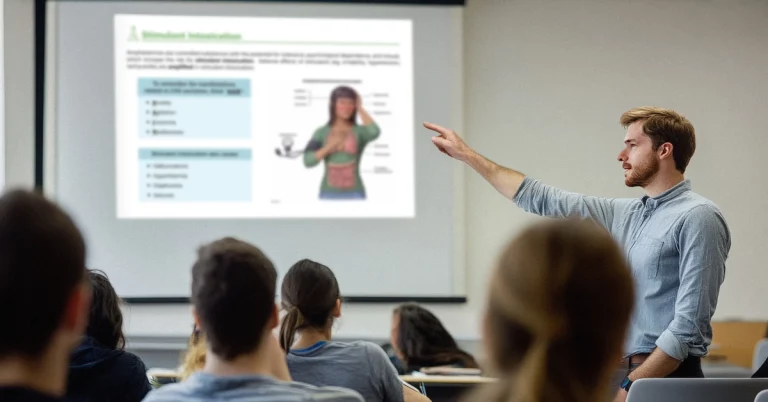By – Kristi Jo Wilson, Ph.D., RN, MSN, FNP-BC, CAFCI
University of Michigan-Flint
Picture this:
The settin
g is a group of senior nursing students arranged in a Brady Bunch style screen view while attending an online class that focuses on preparing for the NCLEX-RN®.
This particular class involves working through questions or case studies so that I can see their thinking.
Although the virtual environments were initially a stretch for me, I am becoming more and more acclimated, and that is a lot for me to say as a tried and true baby boomer.
I pull up the slide with a question listed and ask, “What kind of thinking is required to answer this question?” I see blank faces (or no faces at all due to the current virtual mode of delivery) followed by crickets (i.e., silence).
After a long pause, one student volunteers the correct answer. I say, “Thank you for your input, but let’s take this back a bit. I want to hear and see your thinking. Tell me what did you notice initially when you read the question.” After a long period of silence, the students hesitantly offer their ideas, which usually skirt around my original question.
One student asks, “Are you asking about what words resonate with us as we read the question?” And so it begins – an exposure to the processes that are involved in critical thinking. I then start to observe the students become more aware or conscious of their thinking. It is at this time (when their ears are perked and antennas up) when I tell them that these types of exercises are integral in creating our paradigm of thinking as nurses.
What is critical thinking?
Teaching students how to think critically is, and has been, the foundation of nursing education for decades. Nurse educators emphasize critical thinking in nursing when they include activities for students such as working through a case study or prioritizing patient care.
The concept is embedded within major discourses in nursing that connote our values, thoughts, and expectations of what a nursing student (and nurse) should look like.
There are common themes regarding critical thinking in nursing. For instance, nurse scholars relate it to habits of mind like intuition, emotional intelligence, and contextual knowledge (Christianson, 2020; Scheffer & Rubenfeld, 2000) along with the ability to navigate through a situation with ease (Benner, 2001). Others note there is more research in the educational setting than in the practice setting and a connection to conceptual models is lacking (Zuriguel et al., 2015).
The problem: Teaching opportunities missed
Although critical thinking is stressed in nursing schools, most nursing school curricula do not allow time for students to truly understand critical thinking and the steps involved in the process (Caputi, 2020).
Instead of focusing on understanding the thought processes required while solving a problem (i.e., metacognition), we prioritize the outcome, regardless of how we got there. Grades are emphasized (outcomes) as well as points earned (outcomes), but we do not emphasize the perspectives or thought processes that are applied to get to the end point.
There are many reasons why there can be a lack of emphasis in this regard. With the multitude of diseases students have to understand before venturing out in practice, it makes sense as to why the curriculum is so content laden. This pinches out any opportunity to venture away from the priorities of transferring information to the student.
However, preserving the space and time to help students understand the epistemological process is key to a more holistic understanding of a concept and leads to a deep retention in learning and easier recall (Caputi, 2020).
“It’s like a layer cake!”
This is what a senior student noted in class when we went through the layers involved in critical thinking. These steps include noticing and analyzing information, along with responding and reflecting (Caputi, 2020).
The layers of critical thinking can be made evident to the students but they have to be emphasized by educators during the learning process.
For instance, if I neglected to make the students more aware of their thought processes while solving a question, I would be decreasing the chance of increased awareness and/or knowledge. This emphasis is also made clear to me when the students perform simulations and they have to navigate through an unexpected situation.
When I meet for debriefing with each student, we talk about each scenario and how they responded. It is exhilarating and empowering (for myself and the student) when the student “gets it” by understanding the facets of critical thinking by identifying the thought processes that drove the psychomotor activity.
One student said something like “I liked that I didn’t freeze up when the patient showed signs of compromise. I could walk and reflect at that same time.” Caputi (2020) calls this “reflection IN action” (p. 15).
In addition, once the students become more aware of the development of knowledge and its layer-like and complex nature, they are more forgiving and kind to themselves in their learning. Instead of feeling less than, they become empowered to learn each step to fully understand what they are developing as a nurse and why.
What is just as powerful is the idea of mutuality between teacher and student. I am applying critical thinking as I reflect on the situation and this supports my personal and professional development as a teacher (Brookfield, 1995).
Conclusion
When I first became a nurse educator, I used to dread the beginning of the semester that was filled with unknowns and anticipated problems. As I started to reflect more on the process of learning (and guiding the students through it), I have added more dimension and traction to my pedagogy and in doing so, I have become more effective in guiding the students toward a more holistic way to learn.
I look forward to the dance that occurs between student and teacher. We step on each other’s toes in order to find the rhythm within the process of tearing down a question or problem so that I (and they) can recognize their thinking.
It has been my experience that students are eager to quickly and expeditiously relay the answer they think is correct, but few look forward to performing an autopsy on their thinking. My challenge every semester is to lay the groundwork to encourage patience in thinking about their thinking (Caputi, 2020).
I am excited for these soon-to-be practicing nurses, because they are aware of the fact that critical thinking has many layers and it is a process that needs to be made more conscious in nursing practice.
References
Benner, P. (2001). From novice to expert: Excellence and power in clinical nursing practice. Upper Saddle River, NJ: Prentice Hall.
Brookfield, S.D. (1995). Becoming a critically reflective teacher. San Francisco, CA: Josey-Bass.
Caputi, L. (2020). Think like a nurse: A handbook. Rolling Meadows, IL: Windy City Publishers.
Christianson, K.L. (2020). Emotional intelligence and critical thinking in nursing students: Integrative review of literature. Nurse Educator 45(6), 62-65.
Scheffer, B., & Rubenfeld, M.G. (2000). A consensus statement on critical thinking in nursing. Journal of Nursing Education 39(3), 352-359.
Zuriguel, E., Canut, M.T., Pegueroles, A.F., Liobet, M.P., Arroyo, C.M. & Merino, J.R. Critical thinking in nursing: Scoping review of the literature. International Journal of Nursing Practice 21, 820-830.





